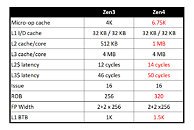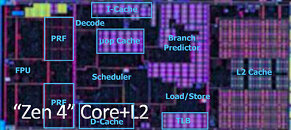- Joined
- Oct 9, 2007
- Messages
- 47,443 (7.50/day)
- Location
- Hyderabad, India
| System Name | RBMK-1000 |
|---|---|
| Processor | AMD Ryzen 7 5700G |
| Motherboard | ASUS ROG Strix B450-E Gaming |
| Cooling | DeepCool Gammax L240 V2 |
| Memory | 2x 8GB G.Skill Sniper X |
| Video Card(s) | Palit GeForce RTX 2080 SUPER GameRock |
| Storage | Western Digital Black NVMe 512GB |
| Display(s) | BenQ 1440p 60 Hz 27-inch |
| Case | Corsair Carbide 100R |
| Audio Device(s) | ASUS SupremeFX S1220A |
| Power Supply | Cooler Master MWE Gold 650W |
| Mouse | ASUS ROG Strix Impact |
| Keyboard | Gamdias Hermes E2 |
| Software | Windows 11 Pro |
As we await technical documents from AMD detailing its new "Zen 4" microarchitecture, particularly the all-important CPU core Front-End and Branch Prediction units that have contributed two-thirds of the 13% IPC gain over the previous-generation "Zen 3" core, the tech enthusiast community is already decoding images from the Ryzen 7000 series launch presentation. "Skyjuice" presented the first annotation of the "Zen 4" core, revealing its large branch-prediction unit, enlarged micro-op cache, TLB, load/store unit, and dual-pumped 256-bit FPU that enables AVX-512 support. A quarter of the core's die-area is also taken up by the 1 MB dedicated L2 cache.
Chiakokhua (aka Retired Engineer) posted a table detailing the various caches and their latencies, comparing it with those of the "Zen 3" core. As AMD's Mark Papermaster revealed in the Ryzen 7000 launch event, the company has enlarged the micro-op cache of the core from 4 K entries to 6.75 K entries. The L1I and L1D caches remain 32 KB in size, each; while the L2 cache has doubled in size. The enlargement of the L2 cache has slightly increased latency, from 12 cycles to 14. Latency of the shared L3 cache is also up, from 46 cycles to 50 cycles. The reorder buffer (ROB) in the dispatch stage has been enlarged from 256 entries to 320 entries. The L1 branch target buffer (BTB) has increased in size from 1 KB to 1.5 KB.


The Zen 4 CCD is slightly smaller than the Zen 3 CCD despite the higher transistor-counts, thanks to the switch to 5 nm (TSMC N5 process). The CCD measures 70 mm², in comparison to the 83 mm² "Zen 3" CCD. The transistor-count of the "Zen 4" CCD is 6.57 billion, a whopping 58 percent increase from that of the "Zen 3" CCD and its 4.15 billion transistor-count.
The cIOD (client I/O die) sees a big chunk of innovation. It's built on the 6 nm (TSMC N6) node, which is a big leap from the GlobalFoundries 12 nm node that the cIOD of Ryzen 5000 series processors were made on. It also incorporates certain power-management features from the Ryzen 6000 "Rembrandt" processors. This cIOD packs an iGPU based on the RDNA2 graphics architecture, besides the DDR5 memory controllers, and a PCI-Express Gen 5 root complex. The new 6 nm cIOD measures 124.7 mm², compared to the slightly larger 124.9 mm² cIOD of the Ryzen 5000 series.
The "Raphael" multi-chip module has one CCD for the 6-core and 8-core SKUs, and two CCDs for the 12-core and 16-core SKUs. "Raphael" is built in the Socket AM5 package. AMD is rumored to be readying a thin BGA package of "Raphael" for high-performance notebook platforms, which it's codenamed "Dragon Range." These processors will come in various 45 W, 55 W, and 65 W TDP points, powering high-end gaming notebooks.
View at TechPowerUp Main Site | Source
Chiakokhua (aka Retired Engineer) posted a table detailing the various caches and their latencies, comparing it with those of the "Zen 3" core. As AMD's Mark Papermaster revealed in the Ryzen 7000 launch event, the company has enlarged the micro-op cache of the core from 4 K entries to 6.75 K entries. The L1I and L1D caches remain 32 KB in size, each; while the L2 cache has doubled in size. The enlargement of the L2 cache has slightly increased latency, from 12 cycles to 14. Latency of the shared L3 cache is also up, from 46 cycles to 50 cycles. The reorder buffer (ROB) in the dispatch stage has been enlarged from 256 entries to 320 entries. The L1 branch target buffer (BTB) has increased in size from 1 KB to 1.5 KB.


The Zen 4 CCD is slightly smaller than the Zen 3 CCD despite the higher transistor-counts, thanks to the switch to 5 nm (TSMC N5 process). The CCD measures 70 mm², in comparison to the 83 mm² "Zen 3" CCD. The transistor-count of the "Zen 4" CCD is 6.57 billion, a whopping 58 percent increase from that of the "Zen 3" CCD and its 4.15 billion transistor-count.
The cIOD (client I/O die) sees a big chunk of innovation. It's built on the 6 nm (TSMC N6) node, which is a big leap from the GlobalFoundries 12 nm node that the cIOD of Ryzen 5000 series processors were made on. It also incorporates certain power-management features from the Ryzen 6000 "Rembrandt" processors. This cIOD packs an iGPU based on the RDNA2 graphics architecture, besides the DDR5 memory controllers, and a PCI-Express Gen 5 root complex. The new 6 nm cIOD measures 124.7 mm², compared to the slightly larger 124.9 mm² cIOD of the Ryzen 5000 series.
The "Raphael" multi-chip module has one CCD for the 6-core and 8-core SKUs, and two CCDs for the 12-core and 16-core SKUs. "Raphael" is built in the Socket AM5 package. AMD is rumored to be readying a thin BGA package of "Raphael" for high-performance notebook platforms, which it's codenamed "Dragon Range." These processors will come in various 45 W, 55 W, and 65 W TDP points, powering high-end gaming notebooks.
View at TechPowerUp Main Site | Source






